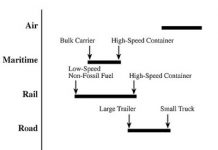Jim Lane
 Four new technologies approach scaled operations, all with one element in common – Velocys (VLS.L) technology on the back-end.
Four new technologies approach scaled operations, all with one element in common – Velocys (VLS.L) technology on the back-end.
Why Velocys, why now? The Digest investigates.
In Oklahoma, Southeast Oregon, Eastern Ohio, and a site near London we’re about to see the commercial-scale debut of Velocys technology, a smaller scale gas-to-liquids processing technology that converts natural gas or biomass into premium liquid products, such as diesel and jet fuel. In this case, specifically designed for smaller scales, resulting in standardized modular plants that are economic, easier to ship and faster to install, at lower risk, even in the most remote locations.
 Velocys makes what’s called micro-channel FT technology, and two of the major aviation biofuels projects, Solena (in partnership with British Airways, in the UK) and Red Rock (in partnership with FedEx and Southwest Airlines) are using it at the back-end to convert syngas to fuel. Fischer-Tropsch has been around as a technology for a long-time, but only at a massive scale these are among the first small-scale FT projects ever. It’s not entirely correct to say that the future of sustainable aviation rests on this technology, but it’s not entirely incorrect either.
Velocys makes what’s called micro-channel FT technology, and two of the major aviation biofuels projects, Solena (in partnership with British Airways, in the UK) and Red Rock (in partnership with FedEx and Southwest Airlines) are using it at the back-end to convert syngas to fuel. Fischer-Tropsch has been around as a technology for a long-time, but only at a massive scale these are among the first small-scale FT projects ever. It’s not entirely correct to say that the future of sustainable aviation rests on this technology, but it’s not entirely incorrect either.
More about Velocys
The Digest’s 2015 8-Slide Guide
The Digest’s 2015 5-Minute Guide
Where will it be seen first?
Where will we see it at a “commercial reference” scale first? Probably in Oklahoma, where the Envia Energy Oklahoma City project is underway and will deploy a number of Velocys’ full-scale reactors. It’s now under construction, after a joint venture between Waste Management, Velocys, NRG Energy (NRG) and Ventech was announced early last year and the final investment decision was made (in July 2014) to proceed with construction of the joint venture’s first plant being developed adjacent to Waste Management’s (WM) East Oak landfill site in Oklahoma, USA. Ground breaking took place last May, and mechanical completion is expected in the first half of 2016.
Next? Could be Red Rock or Solena
In July 2012, Velocys was selected by project developer Solena Fuels as sole Fischer-Tropsch supplier to GreenSky London, Europe’s first commercial-scale sustainable jet fuel facility, being developed in partnership with British Airways. A site for this project was selected in April 2014, and the project is expected to be in operation in 2017.
GreenSky London is the first of several waste-biomass to jet fuel projects planned by Solena. Approximately 575,000 tonnes per year of post-recycled waste, normally destined for landfill or incineration, will instead be converted into 120,000 tonnes of clean burning liquid fuels. British Airways has committed to purchasing all 50,000 tonnes per annum of the jet fuel produced at market competitive rates on a long-term basis.
Meanwhile, in September 2014, Red Rock Biofuels was selected to receive a $70 million grant through the US Department of Defense to construct a biomass-to-liquids plant in Oregon, USA that will incorporate Fischer-Tropsch technology from Velocys. Red Rock Biofuels, a subsidiary of IR1 Group, is experienced in constructing and operating commercial scale biofuel facilities.
What about natgas?
Last year, Velocys announced the acquisition of Pinto Energy LLC and the Ashtabula GTL project. This represents a significant step in the North American oil & gas industry’s adoption of smaller scale GTL and of the Velocys technology, accelerating the development of “shovel ready” projects. As its first facility, Pinto Energy is developing an approximately 2,800 barrels per day (bpd) plant at an 80 acre industrial site that it owns near the Port of Ashtabula, Ohio, USA.
The project will benefit from both access to abundant low-cost natural gas from the Marcellus shale region and substantial existing infrastructure. Initial engineering for the facility is complete and the air permit has been issued. Final investment decision is expected within six to nine months. Future expansions could see installed capacity of 10,000 bpd or more at the site. In addition to Ashtabula, Pinto Energy has a pipeline of smaller scale GTL projects it is seeking to develop throughout North America.
Where can you see it today?
The Velocys Pilot Plant is operating in Plain City, Ohio this integrated GTL facility includes Velocys’ microchannel FT and steam methane reforming reactors.
How much does Velocys make out of these projects?
Some time back, Velocys indicated that successful implementation of the GreenSky London project and receipt of the notice to proceed is expected to generate more than $30M to Velocys during the construction phase, and additional ongoing revenues of more than $50M over the first 15 years of the plant’s operation.
Why aren’t investors falling all over a technology that can tap new value in stranded gas?
Well, stranded gas may stay stranded a little longer. Just two years ago, we had $2 gas and $90 oil. Now, we have $2 gas and $40 oil a lot of enthusism has gone out of the GTL space because the crack spread has narrowed considerably.
When will demand recover for GTL technologies?
Ultimately, we’ll see more enthusiasm when demand for liquid energy recovers it’s been sluimping in China, and even a resurgence in gasoline demand in the US it’s up several points since oil prices crashed hasn’t shored up oil prices in the face of a surge in US production around fracking technology, and a “no backing down on market share” strategy from OPEC.
Will biomass or natgas be the big winner?
It’s really not a case of fossil feedstock vs biofeedstock, it’s all about advantaged feedstock. Smart investors will take a portfolio approach. As LanzaTech CEO Jennifer Holmgren says, “never fall in love with a feedstock”. 10 years ago, it was all about corn sugars and soybean oil. Then, cellulosic energy crops, then cellulosic residues. Then, the rage was for cheap Brazilian sugar. Then, along came algae, then it was advantaged natgas will save the world. Most recently it is “oil prices will be low, possibly for 10 years”.
Virtually every feedstock excepting coal and palm oil have received significant amounts of global love at some point in the last decade?
Two lessons there. One, think portfolio, don’t pick stocks and don’t pick feedstocks. Two, the drive towards sustainability will occasionally be interrupted by temptingly low short-term prices, but environmentally-sustainable feedstocks that are cost-advantaged will be double-advantaged, and that’s formidable. The days of single-attribute feedstocks e.g. low on price or low on carbon, but not on both, are increasingly numbered and will end as soon as the project development crowd gets its messaging right and insists on sustainable certification and a public-imposed low-carbon benefit for technol
ogies that deliver cleaner air, because that is a benefit to the public not to the investor.
But, then there’s policy-advantaged feedstock as well meaning sustainability and there we are at an impasse of sorts in the EU and US. Regulators haven’t seen enough of a robust supply-chain in residues, or enough processing technology roll-out, to robustly enforce biofuels mandates set in the 2000s we’ve seen overt roll-back in the EU, a wishy-washy attitude in the US, and only in California is the drive still on for lower-carbon fuels., The Velocys projects will help with the latter, of course.
One of the key advantages of Velocys technology is that has the small-scale necessary to tap the value in stranded natgas or stranded biomass (e.g. waste residues such as gasified MSW or stranded wood) that helps with finding economically advantaged feedstock.
Jim Lane is editor and publisher of Biofuels Digest where this article was originally published. Biofuels Digest is the most widely read Biofuels daily read by 14,000+ organizations. Subscribe here.







